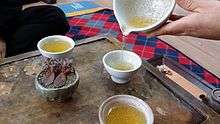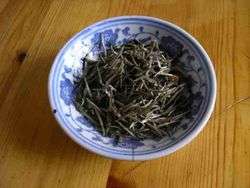Yellow tea
Yellow tea, called huángchá (黄茶; 黃茶) in Chinese and hwangcha (황차; 黃茶) in Korean,[1][2] is a rare and expensive variety of tea.[3]:58 It is produced similarly to green tea, but with an added step of being steamed under a damp cloth after partial oxidation, giving the leaves a slightly yellow colouring during the drying process.[2][3]:32 This process also imparts a mellower and less grassy taste than is found in green teas.[4] The tea is a cross between unoxidized green tea and post-fermented dark tea.[5]
Varieties
Gallery
Tea leaves:
sejak (green tea),
ujeon (green tea),
hwangcha (yellow tea)
Hwangcha
infusing hwangcha
References
- ↑ "黄茶" [huángchá]. LINE Dictionary. Naver Corporation. Retrieved 28 January 2017.
- 1 2 "hwangcha" 황차 [yellow tea]. Standard Korean Language Dictionary (in Korean). National Institute of Korean Language. Retrieved 28 January 2017.
- 1 2 Gascoyne, Kevin; Marchand, François; Desharnais, Jasmin; Americi, Hugo (2011). Tea: History, Terroirs, Varieties. Richmond Hill, ON: Firefly Books. ISBN 9781554079377.
- ↑ Wang, Qiang; Zhao, Xin; Qian, Yu; Wang, Rui (2013). "In vitro antioxidative activity of yellow tea and its in vivo preventive effect on gastric injury". Experimental and Therapeutic Medicine. 6 (2): 423–426. ISSN 1792-0981. doi:10.3892/etm.2013.1117.
- ↑ Gebely, Tony (7 December 2013). "South Korean Balhyocha & Hwangcha". World of Tea. Retrieved 28 January 2017.
|
|---|
Common
varieties | |
|---|
| By country | |
|---|
| Culture | Customs | |
|---|
Associated places | |
|---|
By country | |
|---|
|
|---|
| History | |
|---|
Production and
distribution |
|
|---|
| Preparation | |
|---|
| Tea and health | |
|---|
| Sale | |
|---|
Tea-based
drinks | |
|---|
| See also | |
|---|
|

 Junshan Yinzhen, a famous Chinese tea
Junshan Yinzhen, a famous Chinese tea
.jpg) Hadong hwangcha
Hadong hwangcha Hwangcha
Hwangcha.jpg) infusing hwangcha
infusing hwangcha